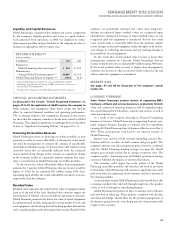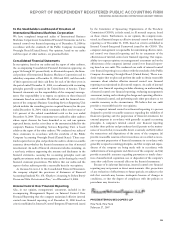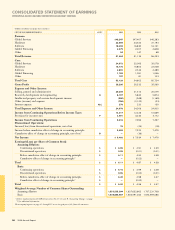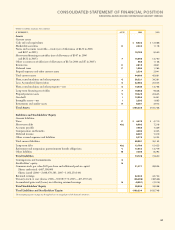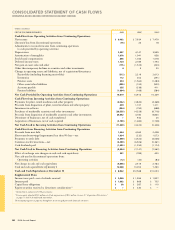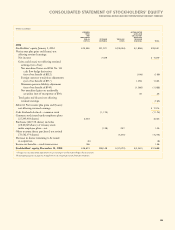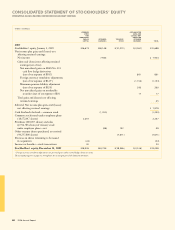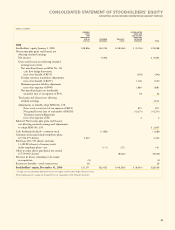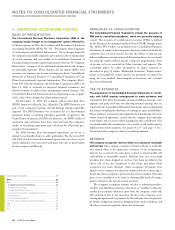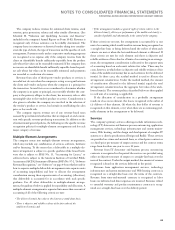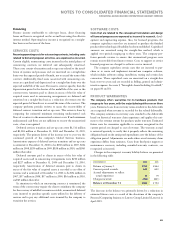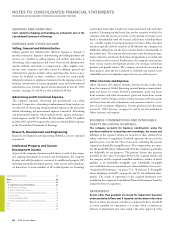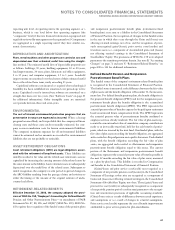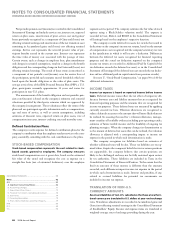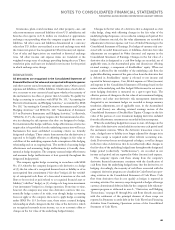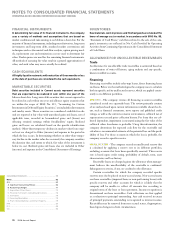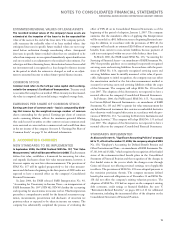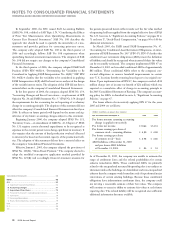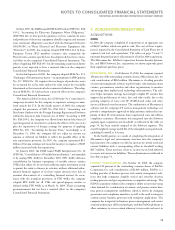IBM 2006 Annual Report Download - page 65
Download and view the complete annual report
Please find page 65 of the 2006 IBM annual report below. You can navigate through the pages in the report by either clicking on the pages listed below, or by using the keyword search tool below to find specific information within the annual report.Black
MAC
CG10
The company reduces revenue for estimated client returns, stock
rotation, price protection, rebates and other similar allowances. (See
Schedule II, “Valuation and Qualifying Accounts and Reserves”
included in the company’s Annual Report on Form 10-K). Revenue is
recognized only if these estimates can be reliably determined. The
company bases its estimates on historical results taking into consider-
ation the type of client, the type of transaction and the specifics of each
arrangement. Payments made under cooperative marketing programs
are recognized as an expense only if the company receives from the
client an identifiable benefit sufficiently separable from the product
sale whose fair value can be reasonably estimated. If the company does
not receive an identifiable benefit sufficiently separable from the prod-
uct sale whose fair value can be reasonably estimated, such payments
are recorded as a reduction of revenue.
Revenue from sales of third-party vendor products or services is
recorded net of costs when the company is acting as an agent between
the client and vendor and gross when the company is a principal to
the transaction. Several factors are considered to determine whether
the company is an agent or principal, most notably whether the com-
pany is the primary obligor to the client, has inventory risk or adds
meaningful value to the vendor’s product or service. Consideration is
also given to whether the company was involved in the selection of
the vendor’s product or service, has latitude in establishing the sales
price or has credit risk.
The company reports revenue net of any revenue-based taxes
assessed by governmental authorities that are imposed on and concur-
rent with specific revenue-producing transactions. In addition to the
aforementioned general policies, the following are the specific revenue
recognition policies for multiple-element arrangements and for each
major category of revenue.
Multiple-Element Arrangements
The company enters into multiple-element revenue arrangements,
which may include any combination of services, software, hardware
and/or financing. To the extent that a deliverable in a multiple-ele-
ment arrangement is subject to specific guidance (like leased hard-
ware that is subject to SFAS No. 13, “Accounting for Leases,” or
software that is subject to the American Institute of Certified Public
Accountants (AICPA) Statement of Position (SOP) No. 97-2, “Software
Revenue Recognition,” see “Software” on page 64) on whether and/or
how to separate multiple deliverable arrangements into separate units
of accounting (separability) and how to allocate the arrangement
consideration among those separate units of accounting (allocation),
that deliverable is accounted for in accordance with such specific
guidance. For all other deliverables in multiple-element arrange-
ments, the guidance below is applied for separability and allocation. A
multiple-element arrangement is separated into more than one unit of
accounting if all of the following criteria are met:
• The delivered item(s) has value to the client on a stand-alone basis;
• There is objective and reliable evidence of the fair value of the
undelivered item(s); and
• If the arrangement includes a general right of return relative to the
delivered item(s), delivery or performance of the undelivered item(s) is
considered probable and substantially in the control of the company.
If these criteria are not met, the arrangement is accounted for as one
unit of accounting which would result in revenue being recognized on
a straight-line basis or being deferred until the earlier of when such
criteria are met or when the last undelivered element is delivered. If
these criteria are met for each element and there is objective and
reliable evidence of fair value for all units of accounting in an arrange-
ment, the arrangement consideration is allocated to the separate units
of accounting based on each unit’s relative fair value. There may be
cases, however, in which there is objective and reliable evidence of fair
value of the undelivered item(s) but no such evidence for the delivered
item(s). In those cases, the residual method is used to allocate the
arrangement consideration. Under the residual method, the amount
of consideration allocated to the delivered item(s) equals the total
arrangement consideration less the aggregate fair value of the unde-
livered item(s). The revenue policies described below are then applied
to each unit of accounting, as applicable.
If the allocation of consideration in a profitable arrangement
results in a loss on an element, that loss is recognized at the earlier of
(a) delivery of that element, (b) when the first dollar of revenue is
recognized on that element, or (c) when there are no remaining prof-
itable elements in the arrangement to be delivered.
Services
The company’s primary services offerings include information tech-
nology (IT) datacenter and business process outsourcing, application
management services, technology infrastructure and system mainte-
nance, Web hosting, and the design and development of complex IT
systems to a client’s specifications (Design and Build). These services
are provided on a time-and-material basis, as a fixed-price contract or
as a fixed-price per measure of output contract and the contract terms
range from less than one year to over 10 years.
Revenue from IT datacenter and business process outsourcing
contracts is recognized in the period the services are provided using
either an objective measure of output or a straight-line basis over the
term of the contract. Under the output method, the amount of revenue
recognized is based on the services delivered in the period.
Revenue from application management services, technology
infrastructure and system maintenance and Web hosting contracts is
recognized on a straight-line basis over the terms of the contracts.
Revenue from time-and-material contracts is recognized as labor
hours are delivered and direct expenses are incurred. Revenue related
to extended warranty and product maintenance contracts is recog-
nized on a straight-line basis over the delivery period.
NOTES TO CONSOLIDATED FINANCIAL STATEMENTS
INTERNATIONAL BUSINESS MACHINES CORPORATION AND SUBSIDIARY COMPANIES
63


